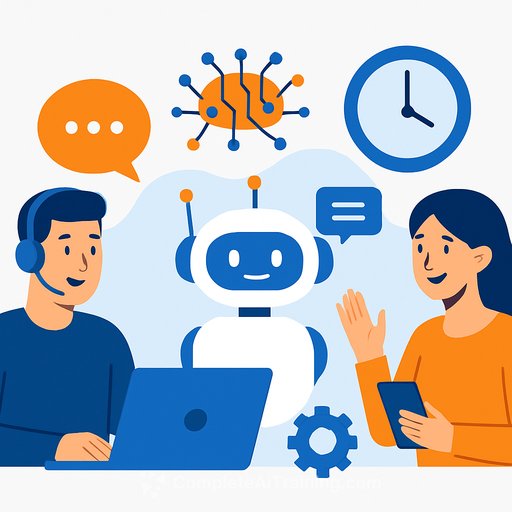From FAQ Bots to Intelligent Support
Most support bots still feel like stiff search bars. They miss intent, ignore context, and send users in circles. Large language models changed what's possible, but plug-and-play isn't enough for enterprise support.
If you want an agent that understands users, references internal knowledge, and keeps learning without putting your brand at risk, you need a clear plan. Here's the practical blueprint from idea to implementation.
Defining the Problem
Traditional support is slow for users and pricey for teams. Long queues, repeated handoffs, inconsistent answers-everyone loses. Scaling headcount helps, but costs climb fast.
Generative AI agents fix the bottleneck when built right. They answer complex questions, pull verified info, and keep the conversation natural. The risk: hallucinations, security gaps, and clunky UX if you rush it.
What LLM Agents Can Do
- Understand complex queries, even with messy phrasing.
- Retrieve answers from internal docs, FAQs, and databases.
- Personalize replies with user context and history.
- Improve over time with feedback and monitoring.
Blueprint of an Enterprise AI Agent
1) Intent Recognition
The agent must detect what the user wants to achieve-track orders, update details, cancel, escalate. Accurate intent drives the right tool or workflow.
- Tools: OpenAI function calling (docs), classification pipelines, LangChain agents with tools.
2) Knowledge Retrieval (RAG)
Models don't know your business out of the box. Retrieval-Augmented Generation connects your agent to your knowledge base so answers are grounded and current.
- Tools: LangChain, LlamaIndex, Pinecone, Weaviate, Qdrant.
3) Prompt Engineering
Your system prompt sets tone, scope, and guardrails. Keep it strict about what the agent can and can't answer.
Example: "You are a helpful support assistant for ACME. Only answer questions about ACME's products. If unsure, escalate to a human."
4) Memory and Context Handling
Conversations should feel continuous, not repetitive. Store session details (order number, email) and, where appropriate, long-term preferences.
- Use token management, context window optimizers, and memory chains.
5) Human-in-the-Loop (Fallback)
Escalation must be seamless. Trigger handoff when confidence is low, data is sensitive, or policy requires a human. Pass the full transcript and context to avoid re-explaining.
- Integrations: Intercom, Zendesk, Freshdesk, Salesforce Service Cloud.
6) Logging, Monitoring & Governance
You need visibility into prompts, responses, retrieval, and outcomes. Monitor for risky behavior, drift, and drop-offs. Build dashboards and alerts.
- Tools: Prompt logging, OpenTelemetry (site), alerts on low-confidence answers.
Choosing the Right Stack
Large Language Model (LLM)
- OpenAI GPT-4 / GPT-3.5: Strong reasoning and multi-turn chat.
- Anthropic Claude 3: Great context handling and safety.
- Mistral / Mixtral: Open-weight options for on-prem.
- Gemini / LLaMA 3: For teams in Google or Meta ecosystems.
For sensitive data or regulated use, consider private hosting or fine-tuned smaller models.
Vector Database (for RAG)
- Pinecone: Managed, easy to scale.
- Weaviate: Open-source, hybrid search support.
- Qdrant: Fast, simple APIs.
- ChromaDB / Milvus: Solid self-hosted choices.
Middleware & Orchestration
- LangChain: Complex agent pipelines and tools.
- LlamaIndex: Document-centric indexing and retrieval.
- RAGFlow / Haystack: Production-grade pipelines.
- OpenDevin / AutoGen: Tool-using or more autonomous agents.
Keep workflows clean. Avoid messy chains and prompt leaks.
Frontend & Integration Layer
- Chat UIs: Custom React/Vue or platforms like Botpress.
- CRM Integrations: Intercom, Zendesk, Salesforce.
- SDKs: Web/mobile embeds for your app or portal.
Add human fallback modals and summary views for agents. UX matters.
From Prompt to Production
Step 1: Design the System Prompt
Set behavior, tone, and boundaries. Be explicit about off-limits topics and escalation rules. Provide formatting guidance if you need structured replies.
Example: "You are an AI support assistant for SwiftShop. Be concise and professional. Only answer queries about products, orders, or policies. If unsure, escalate."
Step 2: Connect the Knowledge Base (RAG Setup)
- Convert FAQs, policies, and CRM exports to text.
- Chunk by section or heading.
- Create embeddings (OpenAI, Cohere, Hugging Face).
- Store in a vector DB (Pinecone, Weaviate, etc.).
- Use a retriever to inject relevant passages into the prompt.
Step 3: Add Memory and Session Context
- Track session data: order IDs, emails, preferences.
- Optionally store cross-session history with consent.
- Use conversation buffers and token trimming to stay within limits.
Step 4: Build Fallback and Escalation Flows
- Score confidence and set thresholds.
- Handoff to live agents with full context.
- Tell the user what's happening: "I'm connecting you now."
Step 5: Test, Monitor, and Launch
- Test edge cases and adversarial prompts.
- Track latency, token usage, and satisfaction.
- Log misses and questionable outputs for review.
- Soft launch, watch closely, iterate weekly.
Security, Compliance & Governance
Data Privacy & Protection
- Mask or redact PII in logs.
- Tokenize sensitive inputs.
- Don't store conversations without explicit consent.
- Choose vendors with strong data handling policies; self-host for higher risk profiles.
Role-Based Access Control (RBAC)
- Authenticate users (OAuth, JWT, SSO).
- Filter retrieval by user role and permissions.
- Adjust agent behavior by user type (customer vs. staff).
Logging & Traceability
- Log prompts, responses, and timestamps.
- Capture sources, snippets, and confidence scores.
- Track escalations and outcomes for QA and audits.
Explainability
- Show source docs or links used in the answer.
- Expose retrieval context to internal reviewers.
- Enable rating and flagging for continuous improvement.
Certifications & Infrastructure
- Look for SOC 2 Type II, ISO/IEC 27001, encryption in transit and at rest.
- Demand SLAs and data residency options where needed.
Measuring Success
First Response Time (FRT)
Target instant replies. Benchmark against your human baseline. Fast and helpful first messages build trust.
Resolution Rate
Track total and first contact resolution. Set targets by use case: e.g., 90% for order status, 60% for account changes. Tie improvements to ROI.
Customer Satisfaction (CSAT)
Use post-chat ratings and sentiment analysis. Watch for repeated fallbacks, rephrasing loops, and drop-offs. Close the loop with fixes each week.
Cost Per Resolution
Compare compute cost vs. human labor. Monitor ticket deflection and AHT impact. Optimize retrieval and token usage to keep unit costs low.
Feedback Loop Success
Are prompts, data chunks, and tools improving week over week? Track the percentage of flagged responses resolved and knowledge updates shipped.
Common Pitfalls to Avoid
- Expecting out-of-the-box magic: Wrap your model with RAG, prompts, tools, and fallback logic.
- Poor retrieval: Bad chunks and stale docs sink answer quality. Clean and evaluate regularly.
- No human fallback: Confident wrong answers hurt trust. Escalate gracefully.
- Weak UX: Laggy chats and confusing errors kill adoption. Polish the interface.
- No monitoring: If you don't watch production, you accept risk. Log, alert, review.
Final Thoughts: Ready to Build Smarter Support?
Enterprise AI agents are practical, but they require thoughtful design, the right stack, and disciplined governance. Start with intent, retrieval, and guardrails. Add memory, handoff, and monitoring. Then iterate fast.
If your team needs upskilling on prompts, RAG, or evaluation, explore focused resources at Complete AI Training - courses by job and prompt engineering. Build the assistant your customers actually want to use.
Your membership also unlocks:






